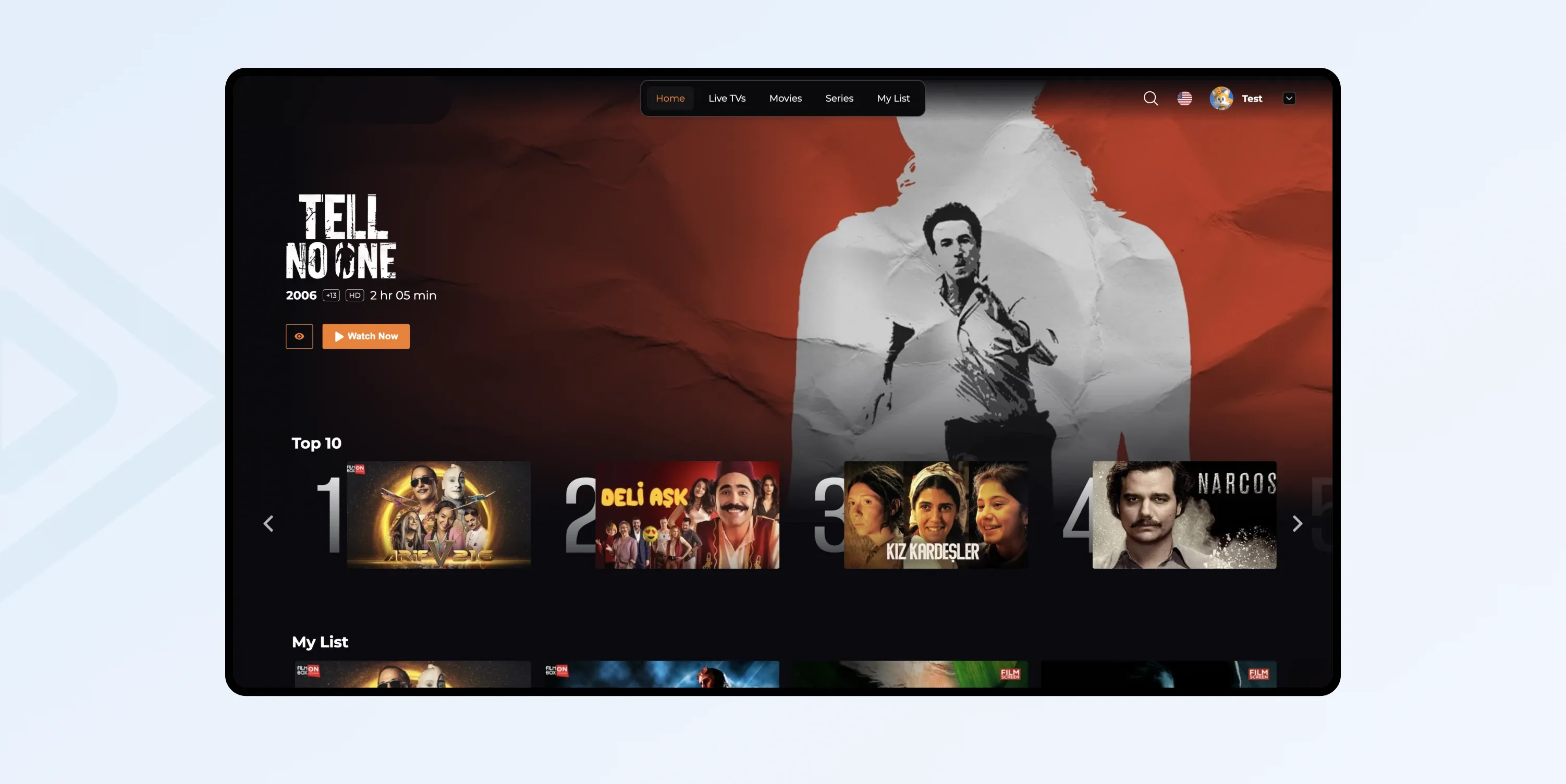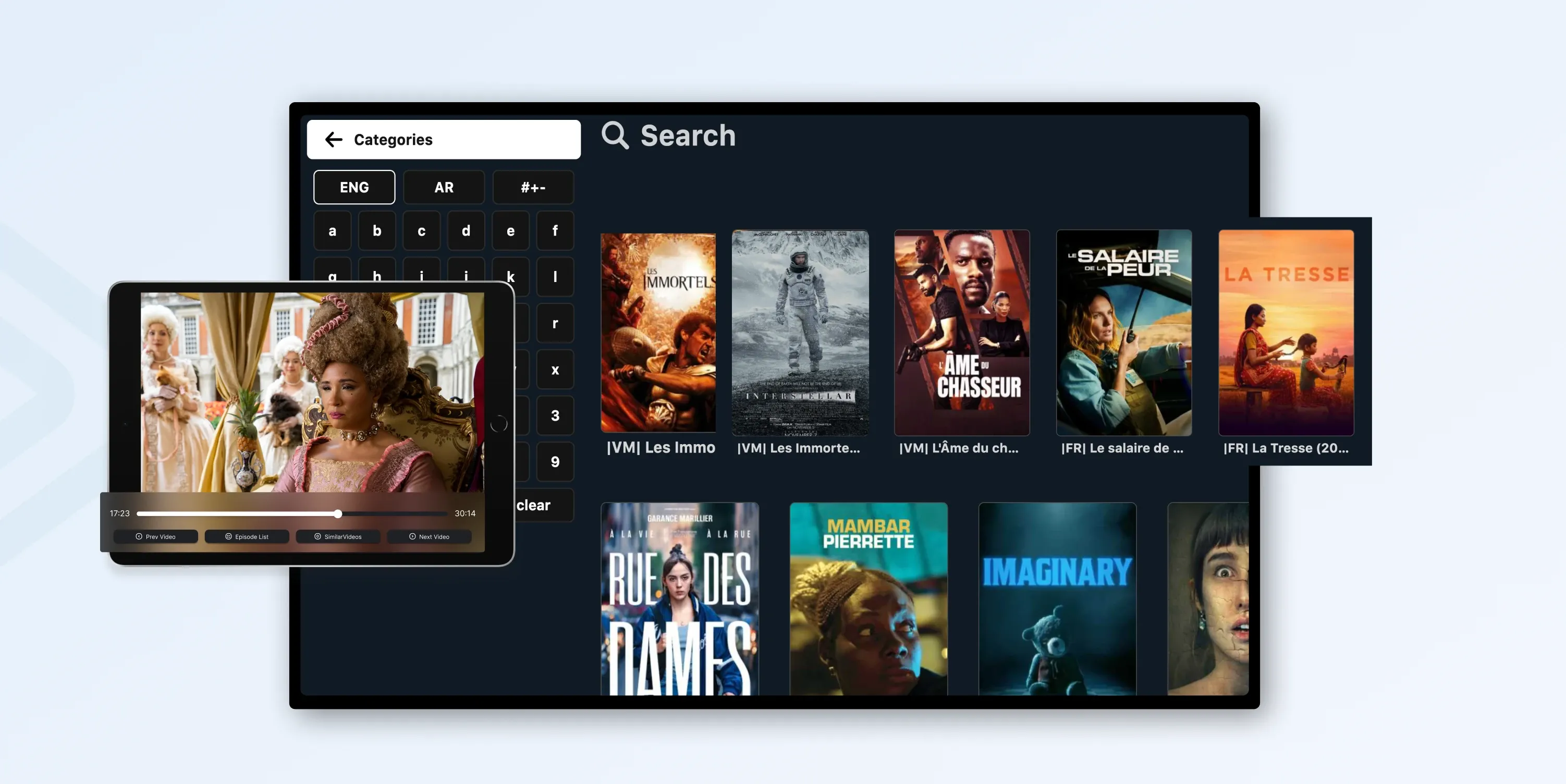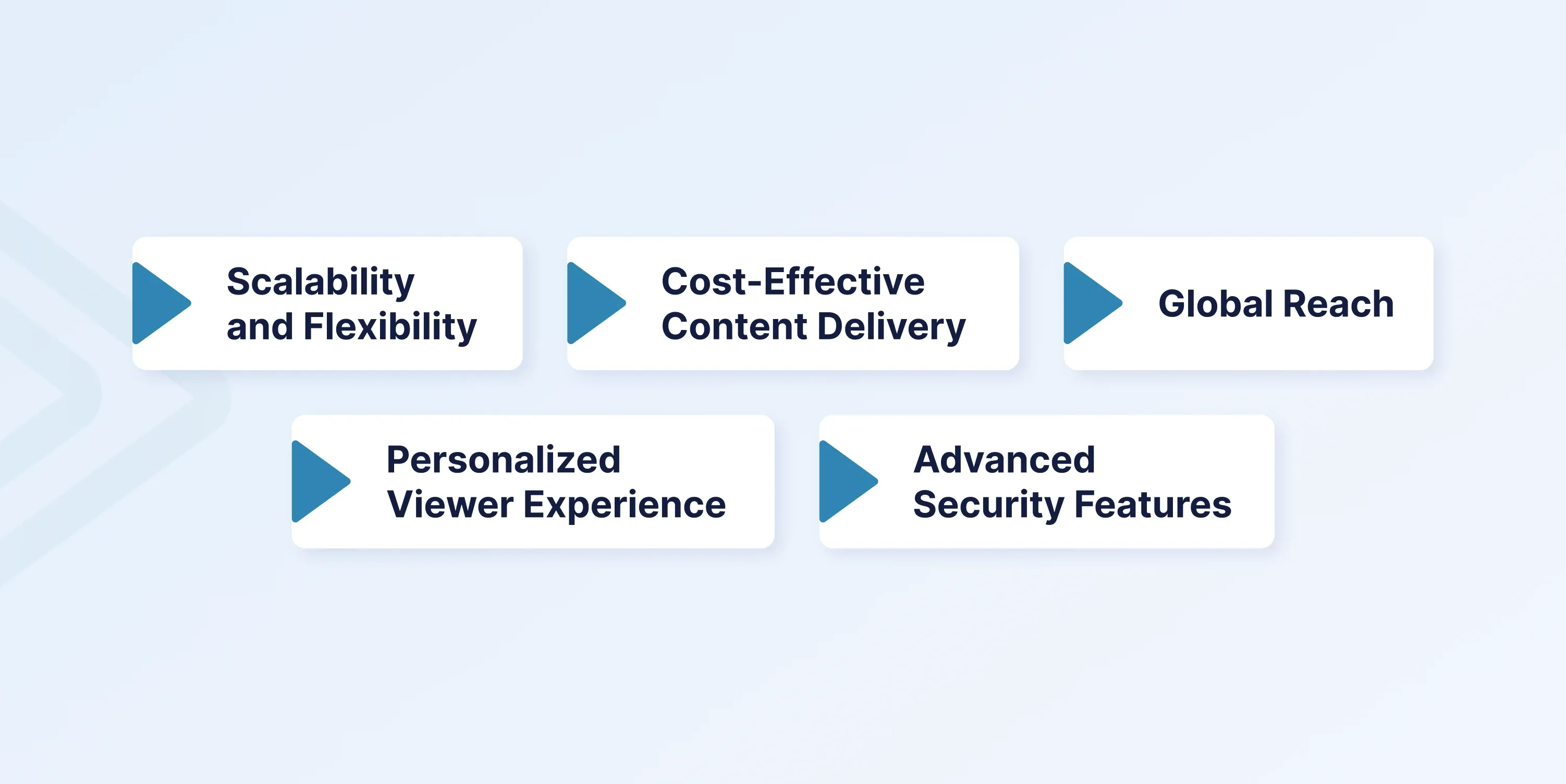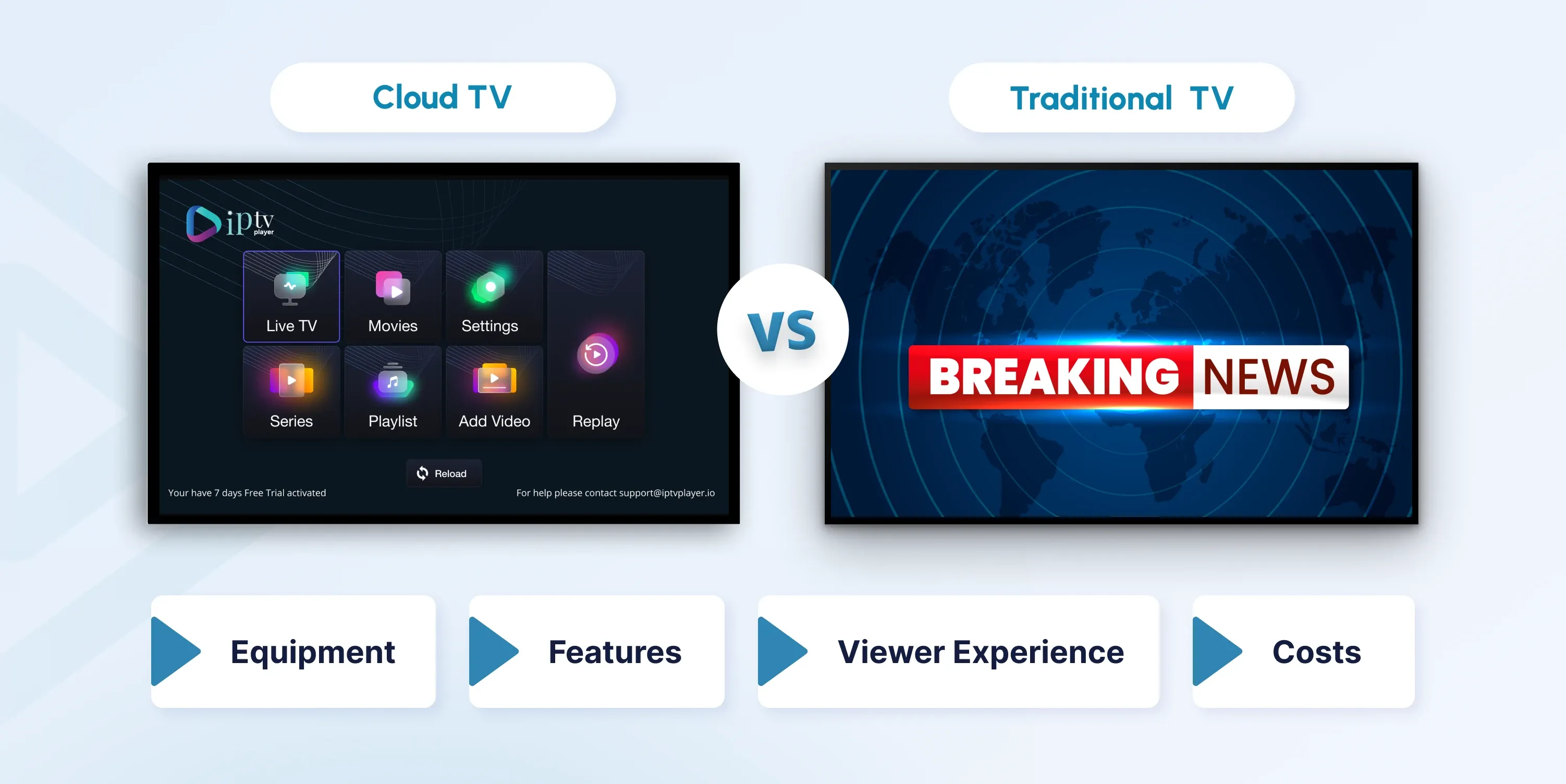
What is Cloud TV? Benefits and Use Cases | 2025 Guide
Cloud TV has become a popular choice in digital broadcasting, offering features and flexibility that traditional TV simply can’t match.
It’s reshaping content delivery, making it accessible anytime, on any device with an internet connection.
This article explores how cloud TV works and what it offers to businesses, content creators, and viewers alike.
Let’s learn about the technology behind cloud TV apps, the benefits, the challenges, and the use cases.

What is Cloud TV?
Cloud TV represents a major shift in media distribution, moving away from traditional broadcasting setups to a more versatile, cloud-based TV service.
Instead of relying on cables or satellites, cloud TV uses internet-based cloud TV platforms to deliver content directly from cloud servers.
This setup allows content creators and businesses to reach viewers across various devices. Whether it’s a smartphone, tablet, or smart TV, users aren’t restricted by device or location.

Content Variety and Device Compatibility with Cloud TV
A cloud TV platform combines the strengths of cloud computing with advanced streaming technology. With cloud-based servers managing storage, processing, and distribution, viewers can enjoy smooth, on-demand content without delays.
This flexible infrastructure scales up easily, helping you engage with broader audiences. New content can be added regularly without hefty hardware investments.
From a single, user-friendly cloud TV platform, you have complete control over your content. You can manage audience insights, adjust cloud TV channel lists, and schedule content seamlessly.
For businesses and creators alike, cloud TV offers the flexibility and scalability needed to meet the evolving demands of digital media.
How Cloud TV Works
Cloud TV revolutionizes video distribution by using cloud technology to store, manage, and deliver content directly to viewers via internet platforms. This completely bypasses traditional broadcast channels.
It’s an innovative approach that empowers content creators, business owners, and TV operators to engage a broader audience—no more limitations of conventional broadcast networks, cable, or satellite services.
The process begins with content uploaded and stored on cloud TV streaming servers, which offer:
- Scalable resources
- Vast storage capacity
- Robust processing capabilities
Like OTT technology, this architecture allows users to access content from anywhere with an internet connection, facilitating highly flexible and customized distribution.
When a viewer wants to watch a show or live broadcast, the cloud TV platform quickly searches these servers for the requested content and streams it over the internet.
Thanks to adaptive bitrate streaming, the technology automatically adjusts video quality based on the viewer's device capabilities and internet bandwidth. The result? A seamless and high-quality experience for everyone.
Cloud TV platforms come equipped with powerful administrative features. These capabilities enable you to monitor subscriptions, manage content access, analyze viewing statistics, and incorporate advertising, all from a single interface.
In an increasingly crowded streaming market, cloud TV helps you maintain flexibility, optimize your content distribution, and deliver tailored experiences.
5 Benefits of Cloud TV
Cloud television offers numerous advantages over traditional TV. It’s an appealing choice for businesses looking to innovate and expand their reach.
 Here are five key benefits cloud TV offers:
Here are five key benefits cloud TV offers:
1. Scalability and Flexibility
One of the standout features of cloud TV is its unmatched scalability. With this technology, you can easily add more programming or serve a larger audience without needing extensive physical infrastructure changes.
This flexibility allows you to align your offerings with viewer demands. As such, your content can stay relevant in a rapidly changing market.
2. Cost-Effective Content Delivery
Operating in the cloud significantly reduces the need for expensive hardware and ongoing maintenance costs. This cost-effectiveness frees up valuable resources that can be redirected toward content creation and marketing efforts.
For smaller businesses aiming to deliver high-quality, affordable services, this advantage is particularly beneficial. This way, they can compete with larger players in the cloud TV market.
3. Global Reach
The internet-based nature of a cloud TV platform enables you to distribute content on a global scale. This means you can reach a far broader audience than traditional television ever could. Transcending geographical borders presents new business opportunities and attracts diverse demographics. It’s an excellent way to grow your audience base and enhance your brand’s visibility.
4. Personalized Viewer Experience
By integrating analytics and artificial intelligence, cloud TV tracks viewer preferences and behaviors, allowing you to tailor content recommendations for each user. This level of personalization enhances user engagement, keeping your audience coming back for more.
The result is a unique viewing experience that sets your platform apart in the competitive cloud television landscape.
5. Advanced Security Features
Cloud TV platforms incorporate robust security measures, including authentication and encryption, to safeguard your content against unauthorized access and piracy. This level of protection is crucial for premium content providers who need to secure their intellectual property while building trust with their audience. With a strong emphasis on security, cloud TV ensures that your content remains protected.
Cloud TV vs. Traditional TV
Cloud TV and traditional TV offer distinctly different viewing experiences, accessibility, and content delivery methods.

Equipment
Traditional television relies on cable or satellite services and requires specific equipment, such as set-top boxes and physical infrastructure.
In contrast, Cloud TV operates entirely over the internet, eliminating the need for additional hardware. This setup ensures high accessibility. Consumers only need an internet connection and a compatible device like a computer, smartphone, or smart TV to enjoy flexible, on-demand viewing from virtually anywhere.
Features
Cloud TV platforms and apps can incorporate interactive elements such as pause, rewind, and personalized recommendations, along with a vast and continually expanding library of content.
Traditional TV, however, typically adheres to a fixed broadcast schedule, limiting viewers to what’s available at specific times.
Viewer Experience
By using advanced analytics, cloud TV can tailor programming suggestions based on user preferences.
Unlike traditional programming, which often adopts a one-size-fits-all approach, Cloud TV provides customized experiences that resonate with individual viewers
Costs
Cost efficiency is another area where cloud TV excels. By sidestepping the substantial operational expenses tied to maintaining physical infrastructure, cloud TV streaming solutions can offer attractive subscription options to consumers.
Conversely, traditional television often incurs higher costs due to maintenance, installation, and equipment expenses. The digital nature of cloud TV reduces these overheads. It’s a scalable alternative for providers and their end-users.
Cloud TV represents a modern, efficient, and user-friendly evolution of content delivery, setting a new standard for the future. With its ability to provide personalized experiences and cost-effective solutions, cloud TV is poised to redefine how viewers consume media compared to traditional television.
Cloud TV Use Cases
From on-demand streaming to interactive live broadcasts, cloud TV is transforming how we watch and engage with content. Let’s dive into the powerful ways it’s being used across industries to deliver seamless, flexible, and personalized viewing experiences.
1. Educational Platforms
Cloud TV is transforming online learning by enabling colleges, universities, and e-learning systems to deliver live and on-demand classes.
Educational institutions can broadcast lectures, tutorials, and interactive workshops, allowing students to access content from any device at any time.
The adaptive streaming capabilities ensure high-quality viewing, even in areas with limited internet connectivity. Integrated video analytics help educators gauge student engagement levels, providing valuable insights into learning outcomes.
2. Fitness and Wellness
The fitness industry leverages cloud TV to offer virtual classes ranging from yoga to high-intensity interval training (HIIT). Trainers and studios can deliver both pre-recorded sessions and live-streamed workouts, giving clients the flexibility to exercise on their schedules.
By incorporating interactive tools and ensuring device compatibility, cloud TV enhances remote health programs. Fitness businesses can expand their reach and create more personalized experiences for their clients.
3. Corporate Training and Development
Many organizations use cloud TV for internal communications, professional development, and staff training.
By streaming presentations, seminars, and training courses to employees across different locations, companies can ensure consistent training without incurring travel expenses.
Cloud TV simplifies content management for HR departments with interactive features and progress tracking. This nurtures and improves the employee learning experience, making training more effective and engaging.
4. Religious and Spiritual Services
Cloud TV enables religious organizations to broadcast events, sermons, and services to a global audience. This capability is particularly beneficial for followers who cannot attend in person. Instead, live-streamed and on-demand content allows them to connect from anywhere.
Features such as subtitles and language customization further broaden the accessibility of services, helping religious institutions foster greater community engagement and support.
5. Real Estate and Virtual Tours
In the real estate sector, cloud TV enables immersive property tours, allowing potential tenants or buyers to view homes from afar. Real estate companies can live-stream property viewings or provide 360-degree virtual tours.
As such, clients can explore multiple properties without needing to be physically present. By offering a scalable and cost-effective solution, cloud TV enhances the buyer experience and significantly expands market reach for real estate businesses.
Challenges of Cloud TV
While cloud TV offers numerous benefits, it also has its challenges.
| Challenge | Description | Solution |
|---|---|---|
| Data Security and Privacy | Streaming companies collect sensitive user data, and a breach can severely damage trust and brand reputation. Global compliance with regulations like GDPR and CCPA adds complexity. | Implement robust encryption, authentication, and monitoring systems to protect user data and maintain consumer confidence. |
| Network Stability and Bandwidth Reliability | Cloud TV depends on high-speed internet. In regions with poor infrastructure, users face buffering, reduced video quality, and service interruptions, affecting satisfaction and retention. | Use adaptive bitrate streaming and Content Delivery Networks (CDNs) to enhance accessibility and streaming quality across varying network conditions. |
| Licensing and Content Delivery | Navigating regional licensing agreements and securing global rights is complex and costly. Smaller companies may struggle to access popular content, limiting competitiveness. | Plan extensively and invest strategically in licensing, considering partnerships or niche content strategies to overcome financial and legal barriers. |
Conclusion
Cloud TV is transforming the way businesses and creators share content, offering a scalable and cost-effective solution with a truly global reach. With cloud TV platforms, companies can elevate user engagement and deliver a smooth, high-quality experience across all devices.
While there are some challenges, like network reliability and data security, cloud TV has quickly become a must-have in the streaming era.
Ready to take your content into the future? inoRain is here to make your cloud TV transition effortless and impactful.
Partner with us to unlock the full potential of cloud TV and reach your audience like never before.
Frequently Asked Questions
Co-founder / CTO
Armen is the CTO and Co-Founder of inoRain OTT and Co-Founder of HotelSmarters, specializing in advanced streaming technologies, OTT strategy, and interactive TV systems. He builds scalable end-to-end video delivery solutions and drives technical innovation across hospitality and streaming platforms, bridging complex engineering with practical business impact.

How to Make a Short Video App (2026 Complete Guide)
Learn how to build a short video app in 2026. Explore micro-drama trends, key features, monetization models, and step-by-step development insights.

OTT Advertising: Types, Best Practices, and Strategies
Over-the-top (OTT) advertising has transformed how brands connect with consumers.

Video Streaming Protocols: Types and Use Cases
Learn about video streaming protocols, how they work, key factors to consider, and the challenges involved in choosing the right protocol.

